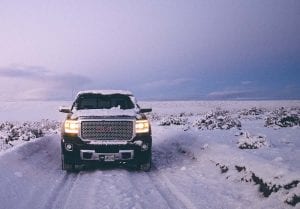Winter driving in severe weather, through snow, ice and freezing conditions, can be difficult and dangerous. Follow these 18 tips.

Here are my top 18 tips for your winter driving travels, whether in a rental car or your own vehicle.
Be prepared to meet winter weather’s challenges:
Driving through sleet, snow and ice is dangerous. Quick starts are ill advised. Stopping takes considerably more distance in those conditions. Be prepared for “black ice,” a thin, transparent, virtually invisible coating of ice on road surfaces, allowing the black road to show through. It’s often formed by rain or melting snow/slush freezing on cold road surfaces, especially on bridges. If conditions for black ice exist, drivers must assume it’s there.
Four-wheel drive and all-wheel drive vehicles don’t brake faster than front-wheel drive or rear-wheel drive vehicles.
Be sure you understand your vehicle’s braking capabilities, regardless of the drive system:
From a safety standpoint, while four-wheel drive and all-wheel drive vehicles are better than both front-wheel drive and rear-wheel drive vehicles to prevent you from getting stuck in winter conditions, the same isn’t true about braking. All cars have four wheel brakes. Four-wheel drive and all-wheel drive vehicles don’t stop more quickly than front-wheel or rear-wheel drive vehicles.
Ensure that your tire tread is more than sufficient:
Tire Rack recommends drivers expecting to encounter snow-covered roads have at least 6/32” (0.5 cm) of remaining tread depth on all vehicles’ tires. Tires need adequate tread depth to compress snow in their grooves and release it as they roll to provide essential vehicle traction and mobility.
Ensure your tires are properly inflated:
Make sure all your car tires are properly inflated, including your spare tire, whether a full size spare, or a donut/space-saver. When correctly inflated, tires are safer and less likely to fail at high speeds. Improperly inflated tires increase stopping distances, will skid longer on wet surfaces, and are less able to prevent vehicle turnovers.
Be sure you have a spare tire, with plenty of tread and proper inflation, plus a full working jack system if traveling by car in winter.
Speaking of spare tires:
Never assume that your rental car has a spare. I recommend against using a vehicle for any car travel that depends solely on a tire inflator kit. Inflator kits can’t overcome large punctures or sidewall damage. A friend of mine was traveling in Arizona a couple of years ago. He got a sidewall puncture on his way to the Grand Canyon and he only had an inflator kit in his rental car. It took four hours to get a tow truck and three more hours to get to the garage. By that time, the garage was closed and he and his family had to stay at a nearby motel overnight. He wouldn’t have lost an entire travel day if the car had a spare.
Ensure that your car has a complete, working jack system:
To use a spare tire, you’ll need a jack assembly in your car. Be sure the entire jack assembly is in the vehicle and be certain you know how to use it. Make sure you know where you safely can place the jack under the car to change the tire. There are typically a finite number of specific under-vehicle locations where it’s safe to place the jack to lift your vehicle.
Safety Tip: It’s not a good idea to drive for long without an available spare, especially in rural areas where road service may not be readily available. Replace or repair your bad tire as soon as possible.
Electric vehicles (EV) have serious challenges operating in frigid weather. EV drivers must be prepared to recharge their vehicle more often than normal.
If driving an electric vehicle (EV), understand its frigid weather battery limitations:
When the temperature drops to 20°F (-7°C) or lower, EVs can lose 30 percent or more of their available power. That’s due to the effect of the cold temperature on battery chemistry and from increased power use to heat the EV’s interior and/or run the windshield and window defrosters. Understand your significant loss of range and make your charging decisions accordingly.
Moreover, don’t forget to use your EV’s preconditioning system to help combat the cold weather’s effect on your EV’s battery.
Make sure your car’s antifreeze level is adequate if driving in cold weather:
You don’t want the engine to fail due to a lack of antifreeze.
Pay attention to weather forecasts at your destination and along your route:
Don’t hesitate to alter your plans according to weather conditions.
In winter weather, increase your following distance, be sure your windshield wipers and washer work and keep your fuel level at 50 percent or higher.
Winter weather following distance:
Add extra distance between your car and the vehicle in front of you, compared to when roads are dry. The three-second rule isn’t enough.
Don’t use cruise control on snowy or icy roads:
Cruise control often reacts unexpectedly on wet roads if your car slips or slides, so turn it off.
Ensure your windshield wipers are in working order:
They need to sweep freely and follow the contour of your windshield properly, without streaking.
Ensure your windshield washer reservoir is filled with “de-icer” fluid:
Top off the reservoir with de-icer, so you’ll have ample fluid to clean your windshield as needed.
Ensure your car has an ice scraper:
If not, buy one.
Keep your fuel tank at least half full at all times:
You never know when a winter weather traffic jam or accident will snarl or stop traffic, plus car woes, such as a flat tire, might strand you for hours. You’ll need plenty of fuel, if stuck, to keep warm in winter and keep your battery charged to power your lights for safety.
Always have a car emergency kit in winter and a fully charged cellphone for emergency calls.
Carry a car emergency kit:
My car emergency kit for winter travel includes a 1000A car battery jump starter, a blanket, water, snacks, first aid kit, small LED emergency flasher and a flashlight.
Have a fully charged cellphone with you in case of emergency:
This is essential whether driving on interstates or back roads. If your cellphone is a smartphone, keep its locator on so friends or family could use an app such as the iPhone’s “Find My,” as an emergency locator. Make sure they have access to find you.
If you’re traveling in areas without cellphone coverage, mostly in western states in wildlife areas, bring a fully charged sat-phone with two-way satellite messaging and interactive global SOS capability.
Make sure a third party has your itinerary and driving route:
Give a friend or family member your itinerary, driving route, and arrival times. If you don’t arrive at your destination on time and you’re unreachable, they can contact local authorities and tell them where to search for you. Have regular check-ins with them.
Driving in cold weather, through sleet, snow, freezing rain, on roads that are wet with rain, snow, slush, ice and particularly unseen black ice, can be difficult and dangerous. That requires caution, even for those used to severe winter driving. For those unfamiliar with winter driving, special care must be taken, as driving in winter conditions takes thoughtfulness and skill.
READ ALSO:
FAA: Changing the overall airspace control agency should be a national priority
No ticket agent satisfaction? Hang up the phone. Call the airline again.
After many years working in corporate America as a chemical engineer, executive and eventually CFO of a multinational manufacturer, Ned founded a tech consulting company and later restarted NSL Photography, his photography business. Before entering the corporate world, Ned worked as a Public Health Engineer for the Philadelphia Department of Public Health. As a well known corporate, travel and wildlife photographer, Ned travels the world writing about travel and photography, as well as running photography workshops, seminars and photowalks. Visit Ned’s Photography Blog and Galleries.


